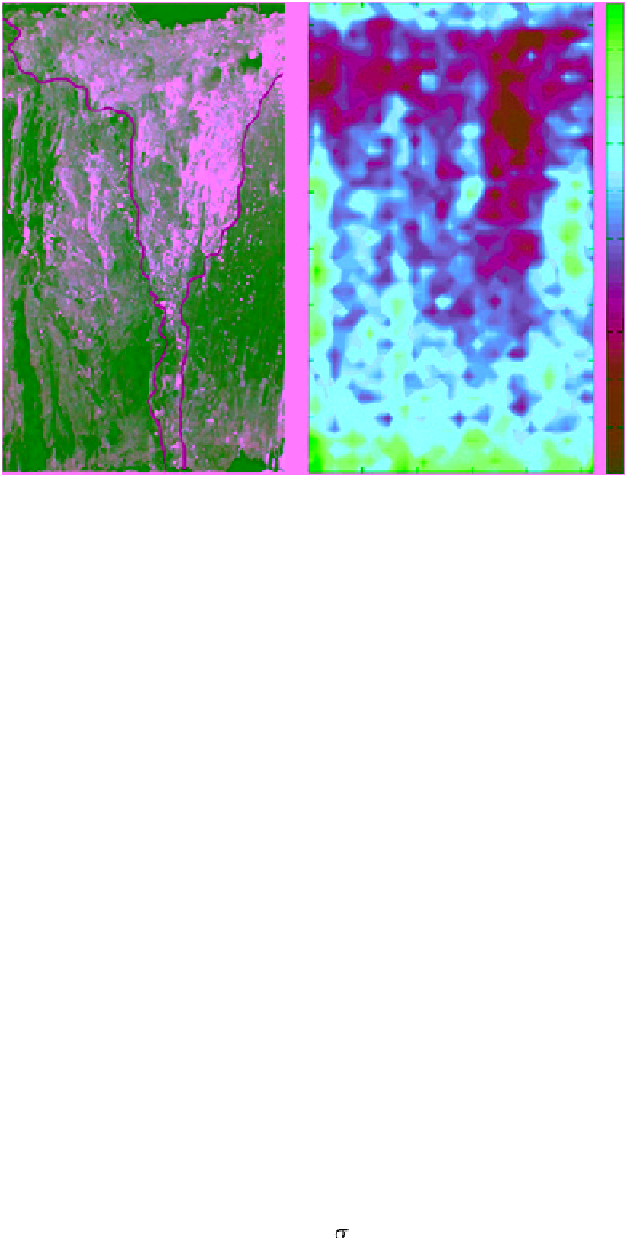Geology Reference
In-Depth Information
0
4.0
-0.1
3.5
-0.2
3.0
-0.3
2.5
-0.4
2.0
-0.5
-0.6
1. 5
-0.7
1. 0
-0.8
0.5
-0.9
0.0
0.0
-1
0.5
1. 0 .5
2.0
2.5
0.5
1. 0 .5
2.0
2.5
Figure 9.22
Optical photograph (left) and infrared photograph (right) of a vertical section of laboratory‐grown sea
ice under a frost flower (not shown). Colder temperatures in the infrared photograph are correlated with the area under
the frost flower, which is delineated by the blue lines in the optical photograph (courtesy of I. Ehlert, Max Planck Institute
of Meteorology, Hamburg, Germany, from
Ehlert,
2012, Fig. 2.16]. (For color detail, please see color plate section).
caused by the ice surface. Therefore, frost flowers do
not have an adverse effect on the estimation of ice con-
centration or any other parameter that can be esti-
mated based on the polarization difference. The
situation is different with the radar observations. Sea
ice areas covered with frost flowers are associated with
significantly higher backscatter than surrounding
areas. This is because of higher salinity and roughness
of the surface. An attempt to model the microwave
scattering from frost flowers is presented in
Pimsamarn
[1997].
The remarkably high backscattering from frost flowers
in SAR images and the fine resolution of those images
make SAR the most suitable sensor for identification of
frost flowers. A first attempt to characterize the radar
backscattering from frost flowers was presented in
Nghiem et al
. [1997]. The authors measured the C‐band
backscatter from frost flowers growing on a surface of
new ice in a freezing pool using a polarimetric SAR sys-
tem. The flowers grew to 10-15 mm in clusters on top of
a slush layer. The study suggested that an increase of
approximately 5 dB can be used as an index to mark the
areal coverage of frost flowers on new ice. It also exam-
ined a few polarimetric parameters and concluded that
the flower‐covered ice had a higher co‐polarized back-
scatter ratio compared to the bare ice surface but no
systematic trend was observed in the cross‐polarized
backscatter ratio.
In a recent study,
Isleifson et al
. [2010] measured back-
scatter of newly formed sea ice during the Canadian
Arctic Shelf Exchange Study (CASES) project in the
Cape Bathurst polynya in the south eastern limit of
the Beaufort Sea in the Canadian Arctic. They used a
C‐band polarimetric scatterometer system mounted on
the port side of the Canadian Coast Guard icebreaker
Amundsen
at a height of about 8 m with respect to the
sea surface. Time series measurements were obtained
from one particular station beginning at a time when
snow was covering frost flowers and running through
the time after the snow was removed and the frost flow-
ers were exposed. Results of co‐ and cross‐polarization
backscattering measurements are shown in Figure 9.23.
While there is virtually no difference between
σ
0
from the
co‐polarization channels in the presence of frost flowers,
there is a relatively large difference in the absence of
frost flowers (with
0
always several decibels higher).
Cross polarization backscatter coefficient is lower than
the co-polarization by the same amount in both
cases. It can be concluded that frost flowers increase
the backscatter by 4.5, 8.3, and 7.0 dB for
vv
0
0
,
, and
vv
hh
0
, respectively. In the absence of frost flowers, there is
evidently more rapid decrease of backscatter with inci-
dence angle.
Isleifson et al
. [2010] also observed that
when the ice was still covered with frost flowers, it had
increased in thickness by only 1 cm during a 12 h period.
When the frost flowers were removed, it increased
hv



